Abstract
Two types of binding sites have previously been described for 36-amino acid neuropeptide Y (NPY), called Y1 and Y2 receptors. Y2 receptors can bind long C-terminal fragments of NPY-e.g., NPY-(13-36)-peptide. In contrast, Y1 receptors have until now only been characterized as NPY receptors that do not bind such fragments. In the present study an NPY analog is presented, [Leu31, Pro34]NPY, which in a series of human neuroblastoma cell lines and on rat PC-12 cells can displace radiolabeled NPY only from cells that express Y1 receptors and not from those expressing Y2 receptors. The radiolabeled analog, [125I-Tyr36] monoiodo-[Leu31, Pro34]NPY, also binds specifically only to cells with Y1 receptors. The binding of this analog to Y1 receptors on human neuroblastoma cells is associated with a transient increase in cytoplasmic free calcium concentrations similar to the response observed with NPY. [Leu31, Pro34]NPY is also active in vivo as it is even more potent than NPY in increasing blood pressure in anesthetized rats. It is concluded that [Leu31, Pro34]NPY is a specific Y1 receptor agonist and that the analog or variants of it can be useful in delineating the physiological importance of Y1 receptors.
Full text
PDF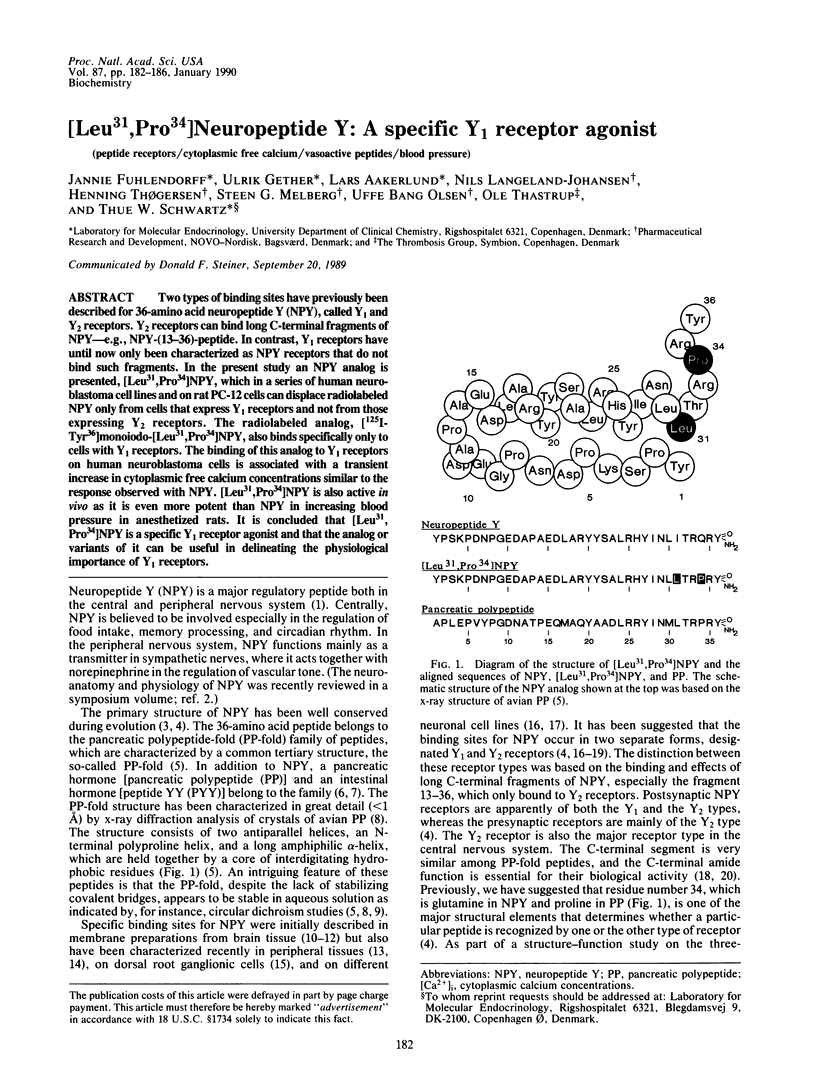
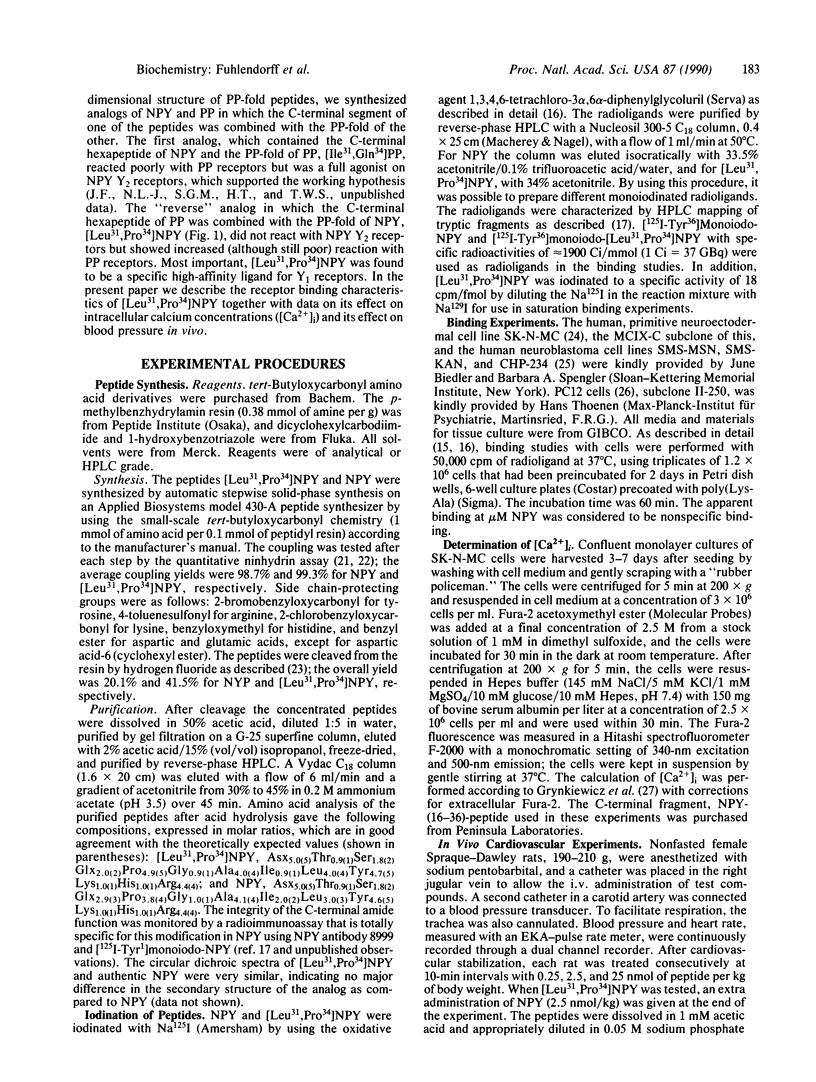
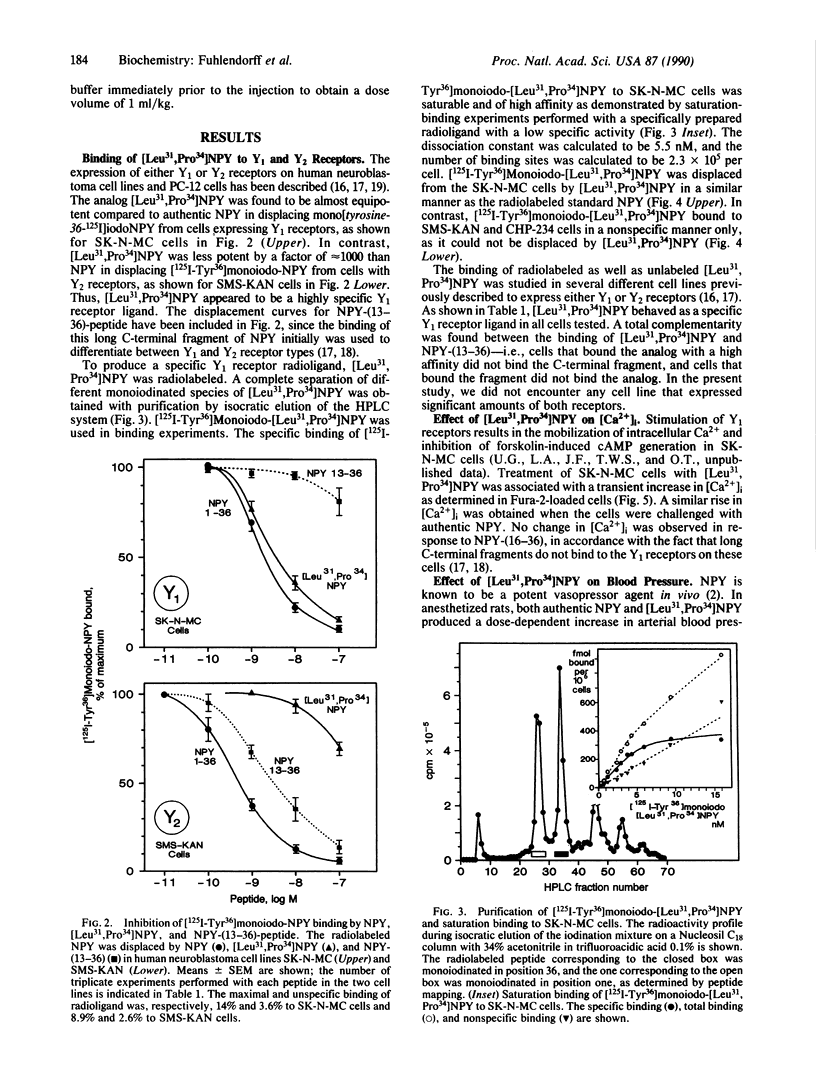
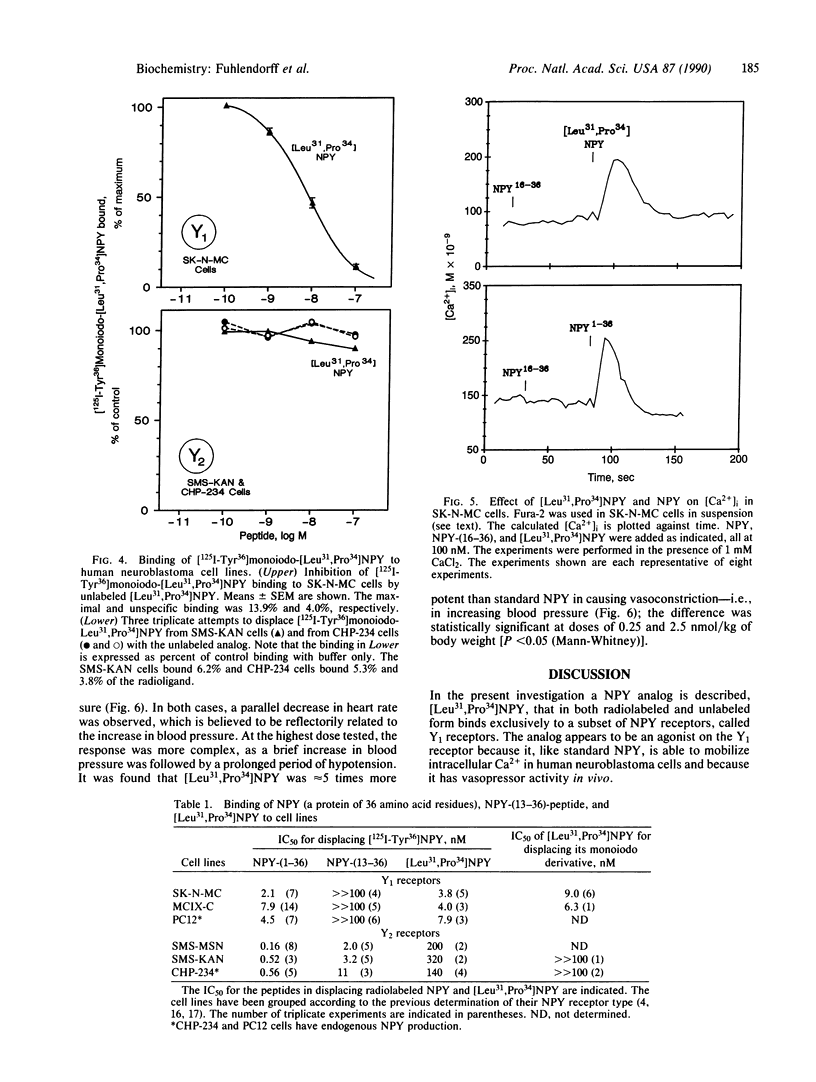
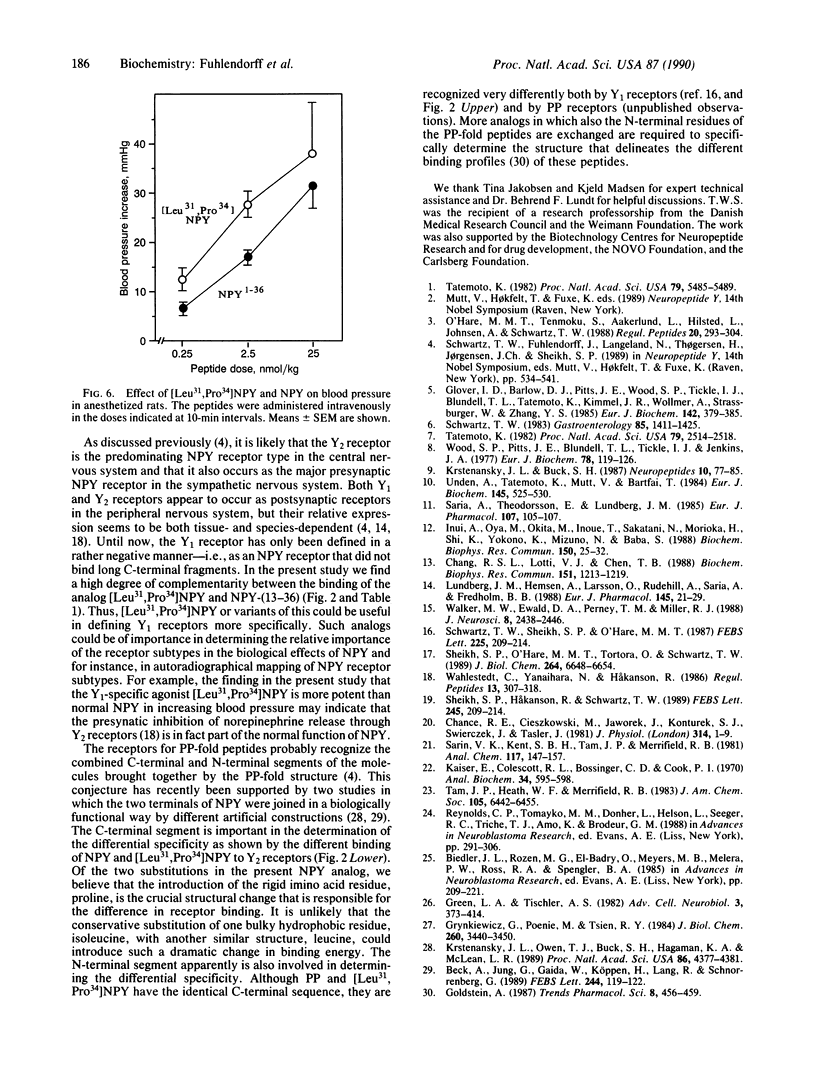
Selected References
These references are in PubMed. This may not be the complete list of references from this article.
- Beck A., Jung G., Gaida W., Köppen H., Lang R., Schnorrenberg G. Highly potent and small neuropeptide Y agonist obtained by linking NPY 1-4 via spacer to alpha-helical NPY 25-36. FEBS Lett. 1989 Feb 13;244(1):119–122. doi: 10.1016/0014-5793(89)81175-5. [DOI] [PubMed] [Google Scholar]
- Biedler J. L., Rozen M. G., el-Badry O., Meyers M. B., Melera P. W., Ross R. A., Spengler B. A. Growth stage-related synthesis and secretion of proteins by human neuroblastoma cells and their variants. Prog Clin Biol Res. 1985;175:209–221. [PubMed] [Google Scholar]
- Chance R. E., Cieszkowski M., Jaworek J., Konturek S. J., Swierczek J., Tasler J. Effect of pancreatic polypeptide and its C-terminal hexapeptide on meal and secretin induced pancreatic secretion in dogs. J Physiol. 1981 May;314:1–9. doi: 10.1113/jphysiol.1981.sp013685. [DOI] [PMC free article] [PubMed] [Google Scholar]
- Chang R. S., Lotti V. J., Chen T. B. Specific [3H]propionyl-neuropeptide Y (NPY) binding in rabbit aortic membranes: comparisons with binding in rat brain and biological responses in rat vas deferens. Biochem Biophys Res Commun. 1988 Mar 30;151(3):1213–1219. doi: 10.1016/s0006-291x(88)80495-9. [DOI] [PubMed] [Google Scholar]
- Glover I. D., Barlow D. J., Pitts J. E., Wood S. P., Tickle I. J., Blundell T. L., Tatemoto K., Kimmel J. R., Wollmer A., Strassburger W. Conformational studies on the pancreatic polypeptide hormone family. Eur J Biochem. 1984 Jul 16;142(2):379–385. doi: 10.1111/j.1432-1033.1984.tb08298.x. [DOI] [PubMed] [Google Scholar]
- Grynkiewicz G., Poenie M., Tsien R. Y. A new generation of Ca2+ indicators with greatly improved fluorescence properties. J Biol Chem. 1985 Mar 25;260(6):3440–3450. [PubMed] [Google Scholar]
- Inui A., Oya M., Okita M., Inoue T., Sakatani N., Morioka H., Shii K., Yokono K., Mizuno N., Baba S. Peptide YY receptors in the brain. Biochem Biophys Res Commun. 1988 Jan 15;150(1):25–32. doi: 10.1016/0006-291x(88)90481-0. [DOI] [PubMed] [Google Scholar]
- Kaiser E., Colescott R. L., Bossinger C. D., Cook P. I. Color test for detection of free terminal amino groups in the solid-phase synthesis of peptides. Anal Biochem. 1970 Apr;34(2):595–598. doi: 10.1016/0003-2697(70)90146-6. [DOI] [PubMed] [Google Scholar]
- Krstenansky J. L., Buck S. H. The synthesis, physical characterization and receptor binding affinity of neuropeptide Y (NPY). Neuropeptides. 1987 Jul;10(1):77–85. doi: 10.1016/0143-4179(87)90091-6. [DOI] [PubMed] [Google Scholar]
- Krstenansky J. L., Owen T. J., Buck S. H., Hagaman K. A., McLean L. R. Centrally truncated and stabilized porcine neuropeptide Y analogs: design, synthesis, and mouse brain receptor binding. Proc Natl Acad Sci U S A. 1989 Jun;86(12):4377–4381. doi: 10.1073/pnas.86.12.4377. [DOI] [PMC free article] [PubMed] [Google Scholar]
- Lundberg J. M., Hemsén A., Larsson O., Rudehill A., Saria A., Fredholm B. B. Neuropeptide Y receptor in pig spleen: binding characteristics, reduction of cyclic AMP formation and calcium antagonist inhibition of vasoconstriction. Eur J Pharmacol. 1988 Jan 5;145(1):21–29. doi: 10.1016/0014-2999(88)90344-5. [DOI] [PubMed] [Google Scholar]
- O'Hare M. M., Tenmoku S., Aakerlund L., Hilsted L., Johnsen A., Schwartz T. W. Neuropeptide Y in guinea pig, rabbit, rat and man. Identical amino acid sequence and oxidation of methionine-17. Regul Pept. 1988 Apr;20(4):293–304. doi: 10.1016/0167-0115(88)90064-x. [DOI] [PubMed] [Google Scholar]
- Reynolds C. P., Tomayko M. M., Donner L., Helson L., Seeger R. C., Triche T. J., Brodeur G. M. Biological classification of cell lines derived from human extra-cranial neural tumors. Prog Clin Biol Res. 1988;271:291–306. [PubMed] [Google Scholar]
- Saria A., Theodorsson-Norheim E., Lundberg J. M. Evidence for specific neuropeptide Y-binding sites in rat brain synaptosomes. Eur J Pharmacol. 1984 Dec 15;107(1):105–107. doi: 10.1016/0014-2999(84)90098-0. [DOI] [PubMed] [Google Scholar]
- Sarin V. K., Kent S. B., Tam J. P., Merrifield R. B. Quantitative monitoring of solid-phase peptide synthesis by the ninhydrin reaction. Anal Biochem. 1981 Oct;117(1):147–157. doi: 10.1016/0003-2697(81)90704-1. [DOI] [PubMed] [Google Scholar]
- Schwartz T. W. Pancreatic polypeptide: a hormone under vagal control. Gastroenterology. 1983 Dec;85(6):1411–1425. [PubMed] [Google Scholar]
- Schwartz T. W., Sheikh S. P., O'Hare M. M. Receptors on phaeochromocytoma cells for two members of the PP-fold family--NPY and PP. FEBS Lett. 1987 Dec 10;225(1-2):209–214. doi: 10.1016/0014-5793(87)81159-6. [DOI] [PubMed] [Google Scholar]
- Sheikh S. P., Håkanson R., Schwartz T. W. Y1 and Y2 receptors for neuropeptide Y. FEBS Lett. 1989 Mar 13;245(1-2):209–214. doi: 10.1016/0014-5793(89)80223-6. [DOI] [PubMed] [Google Scholar]
- Sheikh S. P., O'Hare M. M., Tortora O., Schwartz T. W. Binding of monoiodinated neuropeptide Y to hippocampal membranes and human neuroblastoma cell lines. J Biol Chem. 1989 Apr 25;264(12):6648–6654. [PubMed] [Google Scholar]
- Tatemoto K. Isolation and characterization of peptide YY (PYY), a candidate gut hormone that inhibits pancreatic exocrine secretion. Proc Natl Acad Sci U S A. 1982 Apr;79(8):2514–2518. doi: 10.1073/pnas.79.8.2514. [DOI] [PMC free article] [PubMed] [Google Scholar]
- Tatemoto K. Neuropeptide Y: complete amino acid sequence of the brain peptide. Proc Natl Acad Sci U S A. 1982 Sep;79(18):5485–5489. doi: 10.1073/pnas.79.18.5485. [DOI] [PMC free article] [PubMed] [Google Scholar]
- Undén A., Tatemoto K., Mutt V., Bartfai T. Neuropeptide Y receptor in the rat brain. Eur J Biochem. 1984 Dec 17;145(3):525–530. doi: 10.1111/j.1432-1033.1984.tb08588.x. [DOI] [PubMed] [Google Scholar]
- Wahlestedt C., Yanaihara N., Håkanson R. Evidence for different pre-and post-junctional receptors for neuropeptide Y and related peptides. Regul Pept. 1986 Feb;13(3-4):307–318. doi: 10.1016/0167-0115(86)90048-0. [DOI] [PubMed] [Google Scholar]
- Walker M. W., Ewald D. A., Perney T. M., Miller R. J. Neuropeptide Y modulates neurotransmitter release and Ca2+ currents in rat sensory neurons. J Neurosci. 1988 Jul;8(7):2438–2446. doi: 10.1523/JNEUROSCI.08-07-02438.1988. [DOI] [PMC free article] [PubMed] [Google Scholar]
- Wood S. P., Pitts J. E., Blundell T. L., Tickle I. J., Jenkins J. A. Purification, crystallisation and preliminary X-ray studies on avian pancreatic polypeptide. Eur J Biochem. 1977 Aug 15;78(1):119–126. doi: 10.1111/j.1432-1033.1977.tb11720.x. [DOI] [PubMed] [Google Scholar]


